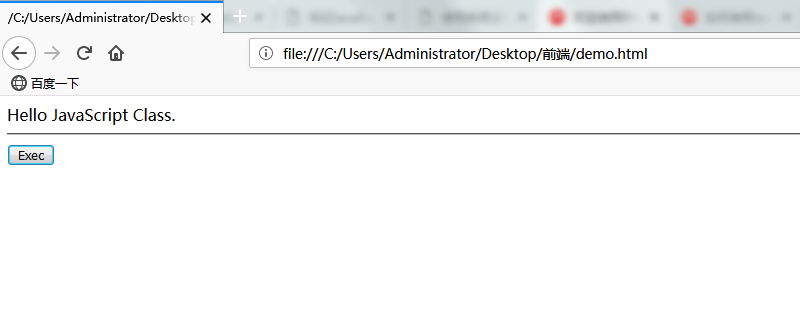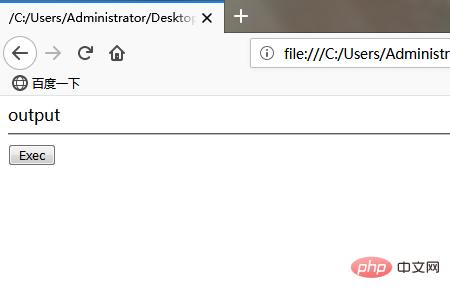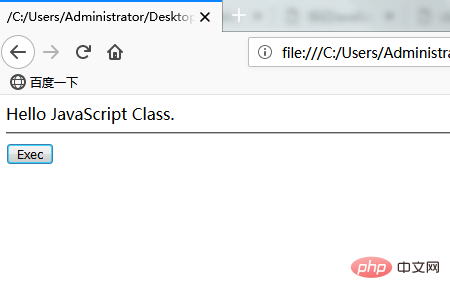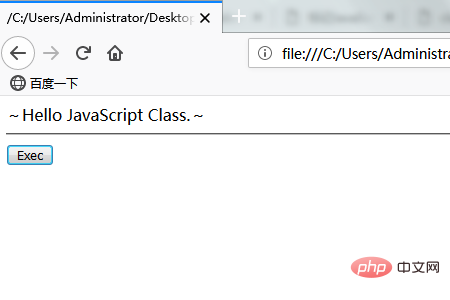 Web Front-end
Web Front-end
 JS Tutorial
JS Tutorial
 Introduction to methods of implementing classes in JavaScript using class syntax
Introduction to methods of implementing classes in JavaScript using class syntax
Introduction to methods of implementing classes in JavaScript using class syntax
#The class syntax for defining classes in JavaScript has been added to ECMAScript 6. In this article, I will introduce the code to implement JavaScript classes using class syntax.

Let’s first look at browser support
Because it needs to correspond to ECMAScript 6, it Available for the following browsers.
Microsoft Edge
Google Chrome 49 or higher
Firefox 45 or higher
Let’s take a look at the syntax format
class (类名){
constructor ([参数...]){
}
(类名1)([参数...]){
...(方法的实现)
}
(类名2)([参数...]){
...(方法的实现)
}
...
(类名n)([参数...]){
...(方法的实现)
}
}Let’s look at a simple example
The code is as follows
<!DOCTYPE html>
<html>
<head>
<meta charset="utf-8" />
<title></title>
<script type="text/javascript">
class MyClass {
method01() {
return "Hello JavaScript Class.";
}
}
function onButtonClick() {
var mclass = new MyClass();
var elem = document.getElementById("output");
elem.innerHTML = mclass.method01();
}
</script>
</head>
<body>
<div id="output">output</div>
<hr/>
<input type="button" value="Exec" onclick="onButtonClick();">
</body>
</html>Instructions:
We use the following code to declare and Implement this class.
Declare the "MyClass" class. MyClass has a method01() method.
method01() method returns a string "Hello JavaScript Class".
class MyClass {
method01() {
return "Hello JavaScript Class.";
}
}By clicking the button, execute the following onButtonClick() function.
function onButtonClick() {
var mclass = new MyClass();
var elem = document.getElementById("output");
elem.innerHTML = mclass.method01();
}var mclass = new MyClass();
The above code creates a MyClass instance. The created MyClass object (MyClass instance) is assigned to the mclass variable.
var elem = document.getElementById("output");
elem.innerHTML = mclass.method01();Call the getElementById() method and get the element (div) with the "output" id. Replace the return value from calling the method1() method of the MyClass class with getting the innerHTML of the element. Change the text at the position of the div tag with "output" as id to "Hello JavaScript Class".
Running results
Use a web browser to display the above HTML file. The effect shown below will be displayed.

Click the [Exec] button. The string that displays "output" is changed to "Hello JavaScript Class". Creating an instance of a class can confirm that the method can be executed.

Finally, let’s look at an example of a constructor
We will introduce the implementation code of a simple class using a constructor.
The code is as follows:
<!DOCTYPE html><html><head>
<meta charset="utf-8" />
<title></title>
<script type="text/javascript">
class MyClass {
constructor(quote) {
this.iquote = quote;
}
method01() {
return this.iquote + "Hello JavaScript Class." + this.iquote;
}
}
function onButtonClick() {
var mclass = new MyClass("~");
var elem = document.getElementById("output");
elem.innerHTML = mclass.method01();
}
</script>
</head>
<body>
<div id="output">output</div>
<hr />
<input type="button" value="Exec" onclick="onButtonClick();">
</body>
</html>Description: The format of class declaration and implementation is the same as the previous code.
constructor(quote) {
this.iquote = quote;
}Use the above constructor to implement the constructor. In this code, the value given to the constructor parameter is stored in the iquote member variable. Member variables can be declared by describing the variable name after "this".
method01() {
return this.iquote + "Hello JavaScript Class." + this.iquote;
}method01() method returns a string "Hello JavaScript Class". The difference from the previous example is that the string given to the constructor parameter is added before and after the string.
function onButtonClick() {
var mclass = new MyClass("~");
var elem = document.getElementById("output");
elem.innerHTML = mclass.method01();
}Clicking the button will execute the onButtonClick() function above. Create an instance of MyClass and assign the return value of the method 1 method to the element with the output ID and display it on the browser.
Running results
Use a web browser to display the above HTML file. The effect shown below will be displayed.

Click the [Exec] button. The string that displays "output" becomes "~Hello JavaScript Class.~". An instance of the class is created and you can see that the method is executable. Before and after the string of "Hello JavaScript Class .", you can confirm that "~" will be executed.

The above is the detailed content of Introduction to methods of implementing classes in JavaScript using class syntax. For more information, please follow other related articles on the PHP Chinese website!

Hot AI Tools

Undresser.AI Undress
AI-powered app for creating realistic nude photos

AI Clothes Remover
Online AI tool for removing clothes from photos.

Undress AI Tool
Undress images for free

Clothoff.io
AI clothes remover

AI Hentai Generator
Generate AI Hentai for free.

Hot Article

Hot Tools

Notepad++7.3.1
Easy-to-use and free code editor

SublimeText3 Chinese version
Chinese version, very easy to use

Zend Studio 13.0.1
Powerful PHP integrated development environment

Dreamweaver CS6
Visual web development tools

SublimeText3 Mac version
God-level code editing software (SublimeText3)

Hot Topics
 1378
1378
 52
52
 How to implement an online speech recognition system using WebSocket and JavaScript
Dec 17, 2023 pm 02:54 PM
How to implement an online speech recognition system using WebSocket and JavaScript
Dec 17, 2023 pm 02:54 PM
How to use WebSocket and JavaScript to implement an online speech recognition system Introduction: With the continuous development of technology, speech recognition technology has become an important part of the field of artificial intelligence. The online speech recognition system based on WebSocket and JavaScript has the characteristics of low latency, real-time and cross-platform, and has become a widely used solution. This article will introduce how to use WebSocket and JavaScript to implement an online speech recognition system.
 WebSocket and JavaScript: key technologies for implementing real-time monitoring systems
Dec 17, 2023 pm 05:30 PM
WebSocket and JavaScript: key technologies for implementing real-time monitoring systems
Dec 17, 2023 pm 05:30 PM
WebSocket and JavaScript: Key technologies for realizing real-time monitoring systems Introduction: With the rapid development of Internet technology, real-time monitoring systems have been widely used in various fields. One of the key technologies to achieve real-time monitoring is the combination of WebSocket and JavaScript. This article will introduce the application of WebSocket and JavaScript in real-time monitoring systems, give code examples, and explain their implementation principles in detail. 1. WebSocket technology
 How to use JavaScript and WebSocket to implement a real-time online ordering system
Dec 17, 2023 pm 12:09 PM
How to use JavaScript and WebSocket to implement a real-time online ordering system
Dec 17, 2023 pm 12:09 PM
Introduction to how to use JavaScript and WebSocket to implement a real-time online ordering system: With the popularity of the Internet and the advancement of technology, more and more restaurants have begun to provide online ordering services. In order to implement a real-time online ordering system, we can use JavaScript and WebSocket technology. WebSocket is a full-duplex communication protocol based on the TCP protocol, which can realize real-time two-way communication between the client and the server. In the real-time online ordering system, when the user selects dishes and places an order
 How to implement an online reservation system using WebSocket and JavaScript
Dec 17, 2023 am 09:39 AM
How to implement an online reservation system using WebSocket and JavaScript
Dec 17, 2023 am 09:39 AM
How to use WebSocket and JavaScript to implement an online reservation system. In today's digital era, more and more businesses and services need to provide online reservation functions. It is crucial to implement an efficient and real-time online reservation system. This article will introduce how to use WebSocket and JavaScript to implement an online reservation system, and provide specific code examples. 1. What is WebSocket? WebSocket is a full-duplex method on a single TCP connection.
 JavaScript and WebSocket: Building an efficient real-time weather forecasting system
Dec 17, 2023 pm 05:13 PM
JavaScript and WebSocket: Building an efficient real-time weather forecasting system
Dec 17, 2023 pm 05:13 PM
JavaScript and WebSocket: Building an efficient real-time weather forecast system Introduction: Today, the accuracy of weather forecasts is of great significance to daily life and decision-making. As technology develops, we can provide more accurate and reliable weather forecasts by obtaining weather data in real time. In this article, we will learn how to use JavaScript and WebSocket technology to build an efficient real-time weather forecast system. This article will demonstrate the implementation process through specific code examples. We
 How to use insertBefore in javascript
Nov 24, 2023 am 11:56 AM
How to use insertBefore in javascript
Nov 24, 2023 am 11:56 AM
Usage: In JavaScript, the insertBefore() method is used to insert a new node in the DOM tree. This method requires two parameters: the new node to be inserted and the reference node (that is, the node where the new node will be inserted).
 Simple JavaScript Tutorial: How to Get HTTP Status Code
Jan 05, 2024 pm 06:08 PM
Simple JavaScript Tutorial: How to Get HTTP Status Code
Jan 05, 2024 pm 06:08 PM
JavaScript tutorial: How to get HTTP status code, specific code examples are required. Preface: In web development, data interaction with the server is often involved. When communicating with the server, we often need to obtain the returned HTTP status code to determine whether the operation is successful, and perform corresponding processing based on different status codes. This article will teach you how to use JavaScript to obtain HTTP status codes and provide some practical code examples. Using XMLHttpRequest
 How to get HTTP status code in JavaScript the easy way
Jan 05, 2024 pm 01:37 PM
How to get HTTP status code in JavaScript the easy way
Jan 05, 2024 pm 01:37 PM
Introduction to the method of obtaining HTTP status code in JavaScript: In front-end development, we often need to deal with the interaction with the back-end interface, and HTTP status code is a very important part of it. Understanding and obtaining HTTP status codes helps us better handle the data returned by the interface. This article will introduce how to use JavaScript to obtain HTTP status codes and provide specific code examples. 1. What is HTTP status code? HTTP status code means that when the browser initiates a request to the server, the service



